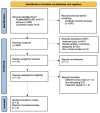Extracellular Vesicles as Novel Diagnostic and Therapeutic Agents for Non-Melanoma Skin Cancer: A Systematic Review
- PMID: 38473864
- PMCID: PMC10931606
- DOI: 10.3390/ijms25052617
Extracellular Vesicles as Novel Diagnostic and Therapeutic Agents for Non-Melanoma Skin Cancer: A Systematic Review
Abstract
Standard non-melanoma skin cancer (NMSC) treatment involves surgery, recently combined with chemotherapy or immunotherapy in cases of advanced tumors. EVs, including exosomes, are integral to carcinogenesis, and are found in NMSC releasing mediators impacting tumor progression. Nevertheless, the precise intercellular signaling role of NMSC-derived EVs remains unclear. This review aims to elucidate their potential role in NMSC diagnosis and treatment. This systematic review encompassed literature searches in electronic databases from inception to September 2023, based on certain inclusion and exclusion criteria, addressing NMSC-derived EVs, their molecular cargo, and their implications in the diagnosis, prognosis, and treatment of NMSC. Key components were identified. Extracellular vesicle (EV) proteins and RNA have emerged as diagnostic biomarkers in EV-based liquid biopsy. Circular RNA CYP24A1, known for its molecular stability, holds promise as a diagnostic biomarker. Long noncoding RNAs (lincRNA-PICSAR) and Desmoglein 2 (DSg2) are linked to drug resistance, serving as prognostic biomarkers. EV mediators are being actively investigated for their potential role as drug delivery agents. In conclusion, this systematic review showed that NMSC-derived EVs display promise as therapeutic targets and diagnostic biomarkers. Further research is imperative to fully comprehend EV mechanisms and explore their potential in cancer diagnosis and treatment.
Keywords: basal cell carcinoma; biomarker; cutaneous squamous cell carcinoma; diagnosis; exosomes; extracellular vesicles; non-melanoma skin cancer; prognosis; treatment.
Conflict of interest statement
The authors declare no conflicts of interest.
Figures
Similar articles
-
Defining the Parameters for Sorting of RNA Cargo Into Extracellular Vesicles.J Extracell Vesicles. 2025 Jul;14(7):e70113. doi: 10.1002/jev2.70113. J Extracell Vesicles. 2025. PMID: 40620070 Free PMC article.
-
Sun protection for preventing basal cell and squamous cell skin cancers.Cochrane Database Syst Rev. 2016 Jul 25;7(7):CD011161. doi: 10.1002/14651858.CD011161.pub2. Cochrane Database Syst Rev. 2016. PMID: 27455163 Free PMC article.
-
Isolation and characterization of bone mesenchymal cell small extracellular vesicles using a novel mouse model.J Bone Miner Res. 2024 Oct 29;39(11):1633-1643. doi: 10.1093/jbmr/zjae135. J Bone Miner Res. 2024. PMID: 39173022 Free PMC article.
-
A promising future for endometriosis diagnosis and therapy: extracellular vesicles - a systematic review.Reprod Biol Endocrinol. 2022 Dec 21;20(1):174. doi: 10.1186/s12958-022-01040-y. Reprod Biol Endocrinol. 2022. PMID: 36544197 Free PMC article.
-
Systemic pharmacological treatments for chronic plaque psoriasis: a network meta-analysis.Cochrane Database Syst Rev. 2021 Apr 19;4(4):CD011535. doi: 10.1002/14651858.CD011535.pub4. Cochrane Database Syst Rev. 2021. Update in: Cochrane Database Syst Rev. 2022 May 23;5:CD011535. doi: 10.1002/14651858.CD011535.pub5. PMID: 33871055 Free PMC article. Updated.
Cited by
-
Bioinformatics and immunoinformatics approaches in the design of a multi-epitope vaccine targeting CTLA-4 for melanoma treatment.Mol Divers. 2025 Jan 28. doi: 10.1007/s11030-025-11108-7. Online ahead of print. Mol Divers. 2025. PMID: 39873886
References
Publication types
MeSH terms
Substances
LinkOut - more resources
Full Text Sources
Medical
Miscellaneous


